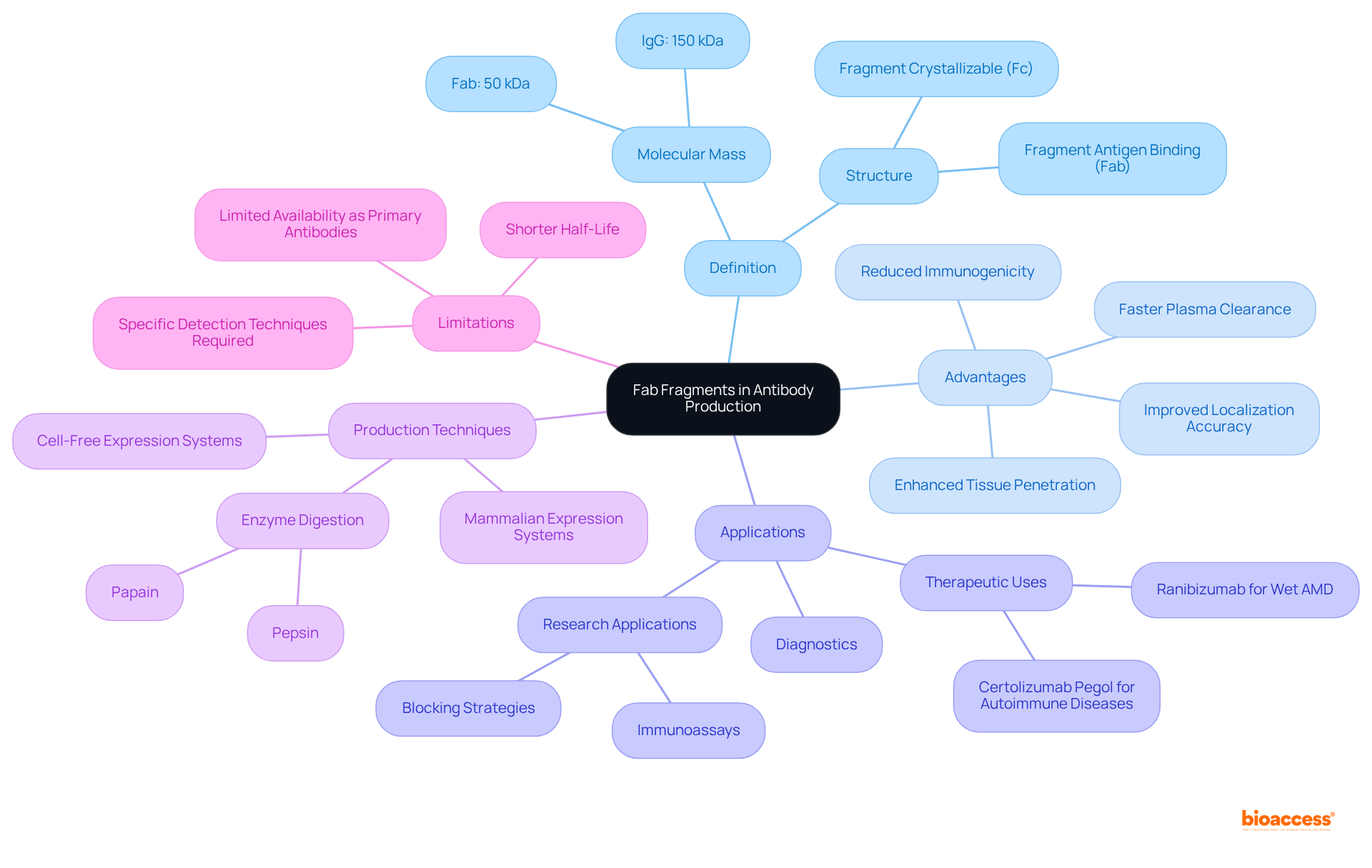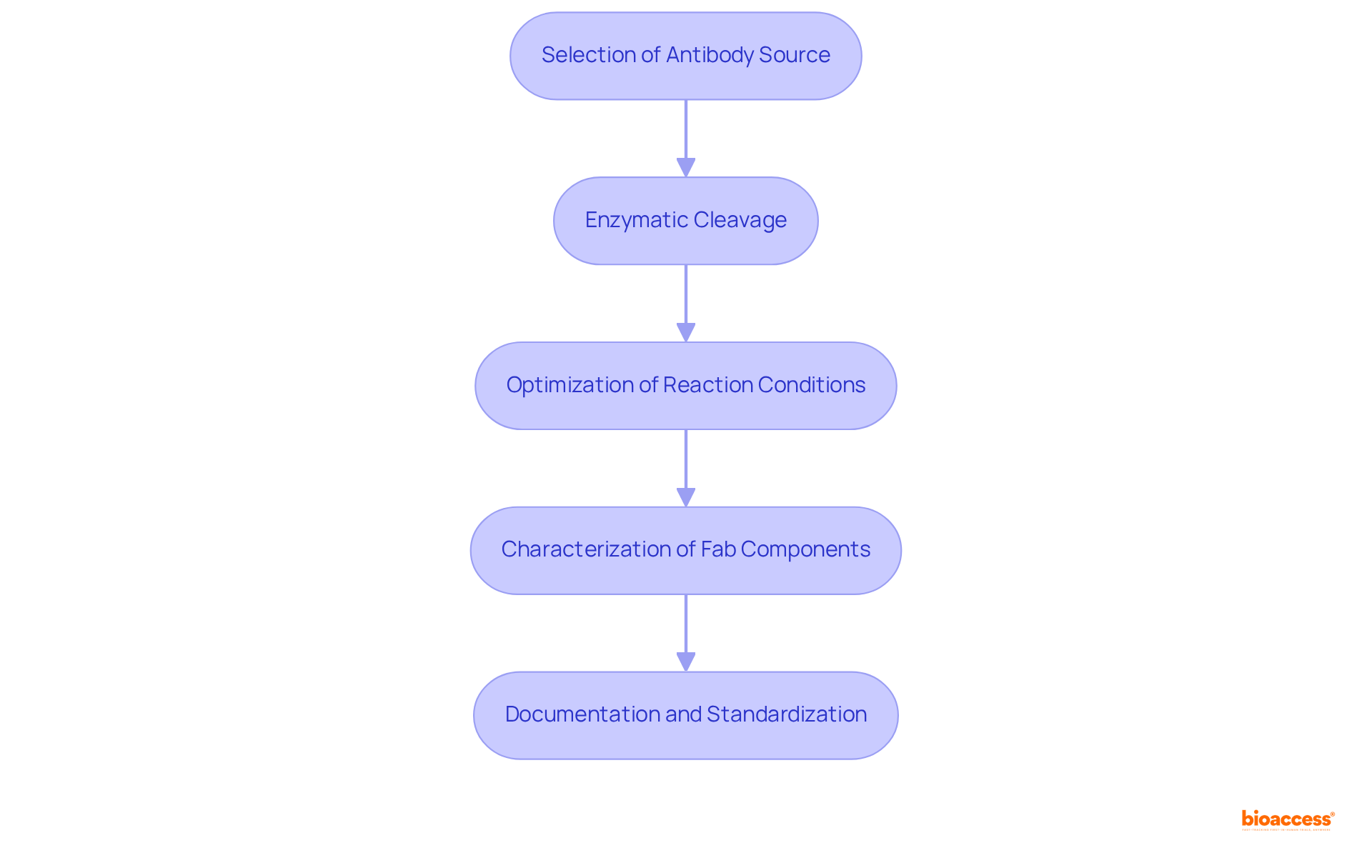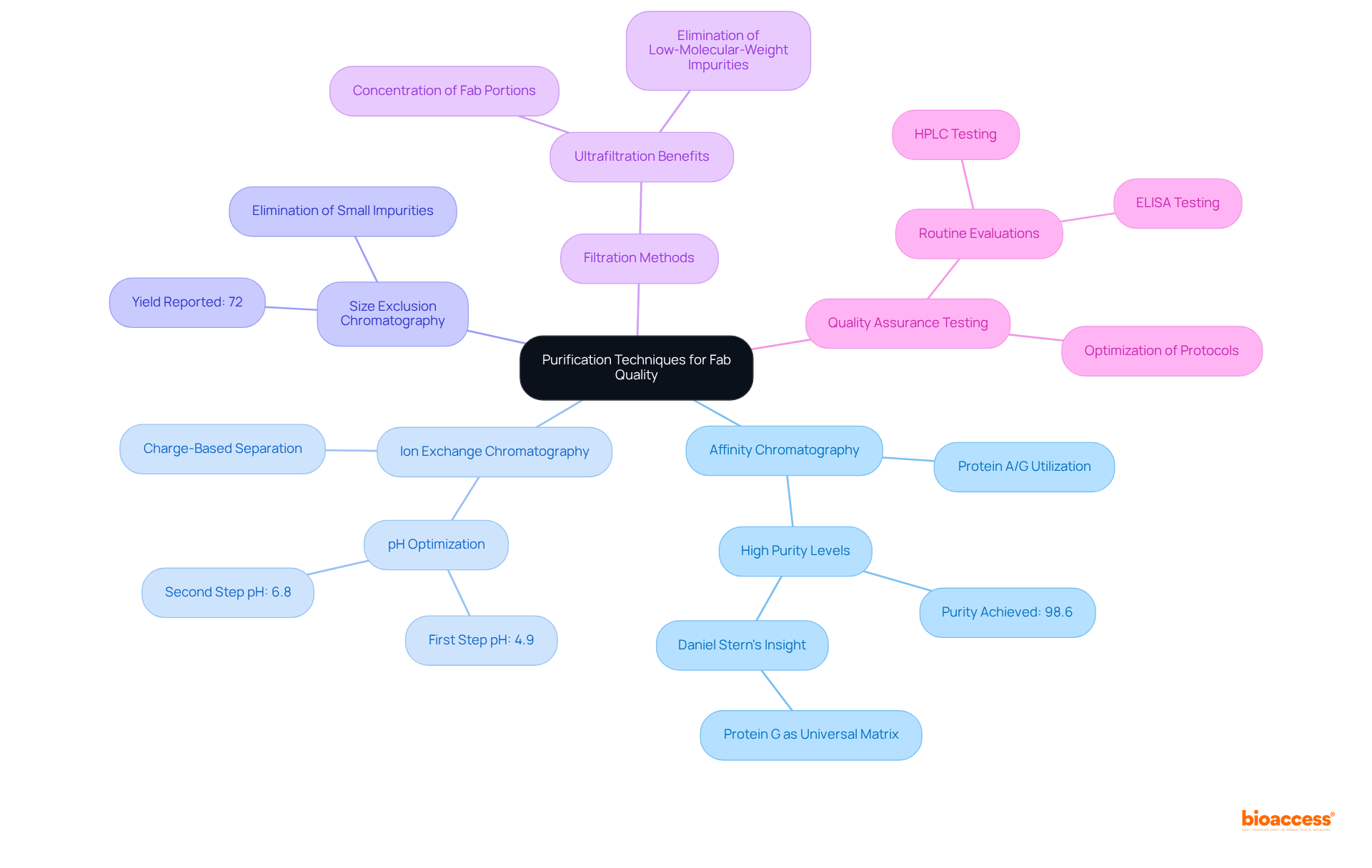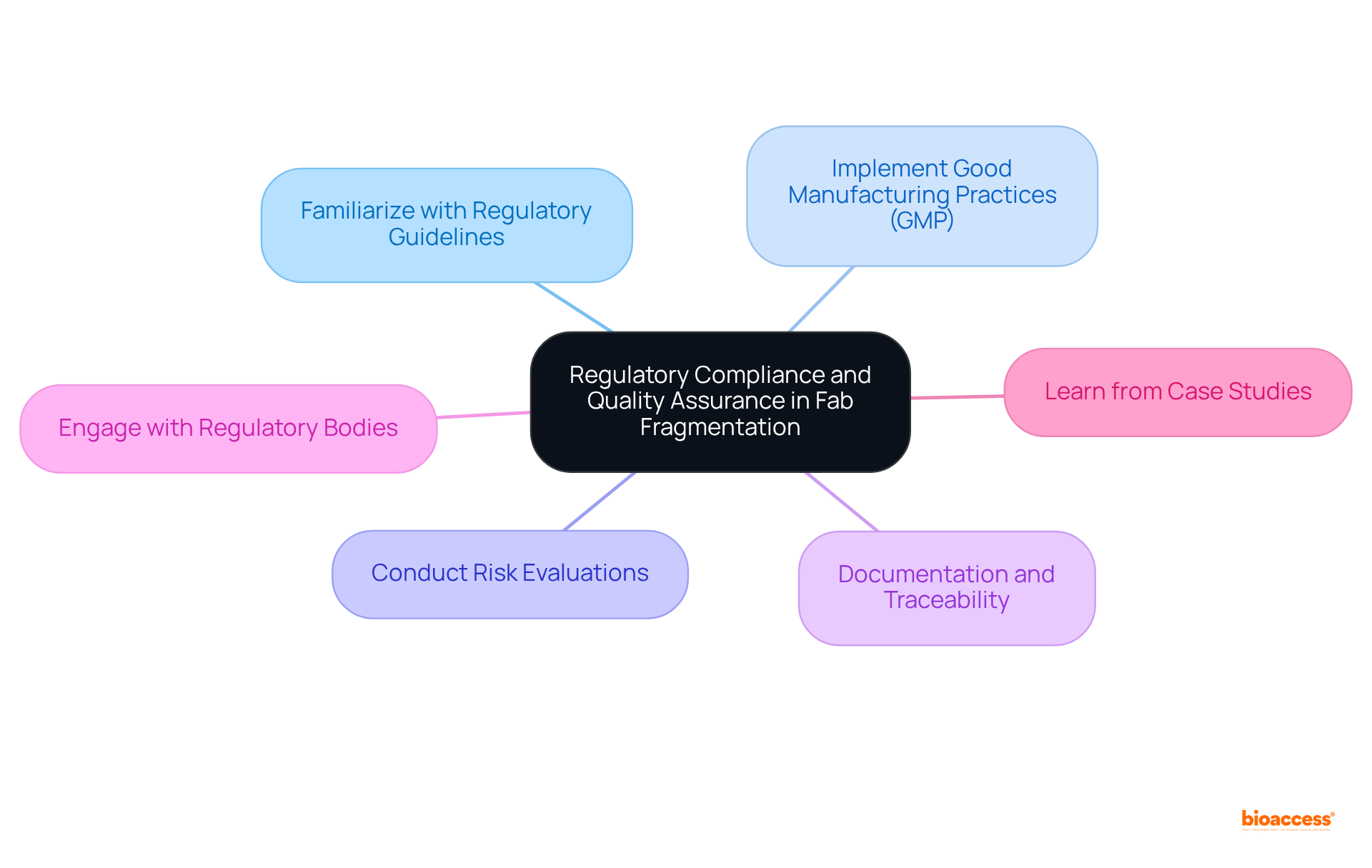


The article outlines four key strategies for effective Fab fragmentation, emphasizing production, purification, and regulatory compliance to enhance therapeutic applications in clinical research. These strategies highlight the critical importance of selecting high-quality antibodies, optimizing enzymatic cleavage and purification techniques, and adhering to regulatory guidelines. Each of these elements is essential for producing reliable and effective Fab fragments, ultimately contributing to the advancement of clinical research. By focusing on these strategies, researchers can navigate the complexities of the Medtech landscape and address key challenges effectively.
Fab fragmentation has emerged as a pivotal innovation in antibody production, transforming the landscape of therapeutic applications. By breaking down antibodies into smaller, antigen-binding fragments, researchers unlock enhanced tissue penetration and reduced immunogenicity, creating opportunities for more effective treatments.
However, the journey from concept to clinical application is fraught with challenges, raising critical questions about the best practices in production, purification, and regulatory compliance.
How can researchers ensure the highest quality of Fab fragments while navigating the complexities of modern biopharmaceutical development?
Fab fragmentation, which refers to the antigen-binding sites, is derived from antibodies through enzymatic cleavage, yielding smaller, versatile molecules that maintain their ability to bind specific antigens. With a molecular mass of approximately 50 kDa, Fab portions are particularly advantageous in therapeutic applications due to their enhanced tissue penetration, faster plasma clearance, and reduced immunogenicity when compared to full-length antibodies, which typically weigh around 150 kDa. This reduced size allows for improved localization accuracy in super-resolution microscopy and facilitates better access to target sites within tissues.
Recent advancements in Fab molecule technology have culminated in the approval of several FDA-approved drugs, including ranibizumab for wet age-related macular degeneration and certolizumab pegol for autoimmune diseases, underscoring their pivotal role in modern medicine. As of April 2025, at least eight Fab antibody drugs have received approval, highlighting their efficacy in treating a variety of medical conditions.
The distinct characteristics of fab fragmentation render it indispensable in diagnostics and targeted therapies, where precision is paramount. Their modularity allows for seamless adaptation in experimental setups, enabling researchers to optimize antibody-based therapies. For instance, Fab pieces can be directly conjugated to reporters or employed alongside secondary antibodies, enhancing specificity and minimizing non-specific binding in complex samples.
Production techniques for Fab pieces typically involve enzyme digestion, such as papain or pepsin, and the use of mammalian expression systems, which are crucial for generating high-quality fragments. Nonetheless, it is important to acknowledge the limitations of Fab portions, including their shorter half-life and the necessity for specific detection techniques, which can complicate their application in certain contexts.
In summary, understanding the function of Fab portions is vital for researchers and developers focused on advancing therapeutic applications. Their ability to improve patient outcomes through targeted interventions underscores the importance of ongoing innovation in fab fragmentation. As T Shantha Raju noted, "The Fc portion is involved in defining antibody effector functions and pharmacokinetic properties by its interaction with Fc receptors, C1q, and FcRn," emphasizing the significance of grasping the complete antibody structure when considering Fab portions for therapeutic use.

To produce high-quality Fab fragments, adherence to best practices is crucial, encompassing several key steps:
Selection of Antibody Source: Opt for a high-affinity monoclonal antibody as the foundational material. This choice is essential for ensuring optimal binding traits in the resulting fab fragmentation, significantly affecting their therapeutic effectiveness. Research has demonstrated that the expression of Fab portions can rise from minimal levels to 10 mg/l when high-affinity antibodies are employed.
Enzymatic Cleavage: Implement specific proteolytic enzymes, such as papain or pepsin, under controlled conditions. This method enables effective cleavage while maintaining the structural integrity of the Fab components, which is crucial for their functionality. Wacker Biotech's research showed that their E. coli secretion system could produce secreted and active antibody pieces exceeding 2 grams per liter, showcasing the effectiveness of proper enzymatic cleavage.
Optimization of Reaction Conditions: Diligently monitor parameters such as pH, temperature, and enzyme concentration. These factors are essential for maximizing yield and minimizing degradation, thereby improving the overall quality of the Fab components produced. The importance of optimizing these conditions is underscored by findings that indicate significant variations in yield based on the chosen vector, strain, and fab fragmentation.
Characterization of Fab Components: Utilize advanced techniques like SDS-PAGE and mass spectrometry to verify the size and purity of the produced Fab components. This characterization is crucial for confirming that the pieces satisfy the necessary criteria for therapeutic uses. The successful characterization of fab fragmentation can lead to enhanced therapeutic results, as shown by various studies in the field.
Documentation and Standardization: Maintain meticulous records of production processes and establish standard operating procedures (SOPs). This practice ensures consistency across batches, which is vital for regulatory compliance and product reliability. Establishing SOPs can assist in preventing typical issues in Fab production, such as inconsistencies in yield and standard.
By adhering to these optimal methods, researchers can greatly improve the standard and dependability of production related to fab fragmentation, ultimately resulting in more effective therapeutic uses. The success rates of high-affinity monoclonal antibodies in Fab production highlight the significance of careful selection and optimization in attaining desired results.

Enhancing purification methods is essential for guaranteeing the quality of fab fragmentation pieces, which is a critical aspect in clinical research. Several strategies can significantly improve purification processes:
Affinity Chromatography: Utilizing protein A or protein G affinity chromatography allows for the selective separation of Fab portions based on their binding characteristics. This approach is recognized for achieving high purity levels, with research indicating that protein G is particularly effective for a wide range of Fab sections. As Daniel Stern noted, 'Our data suggest that protein G is a highly underrated universal matrix for the purification of a broad spectrum of different fab fragmentation, which is superior to other purification matrices,' thereby enhancing overall purification efficiency.
Ion Exchange Chromatography: This technique separates Fab portions based on their charge, further refining the purification process. By adjusting the pH and ionic strength, researchers can optimize the binding and elution of Fab portions, ensuring a more targeted purification. For instance, the pH of the sample load for the first step is adjusted to 4.9, while the second step requires a pH of 6.8.
Size Exclusion Chromatography: Employing size exclusion chromatography effectively eliminates smaller impurities and aggregates, ensuring that only whole Fab portions are preserved. This step is crucial for maintaining the structural integrity of the pieces, which is necessary for their therapeutic effectiveness. The overall yield of the purification procedure was reported as 72%, indicating the effectiveness of these techniques.
Filtration Methods: Ultrafiltration can concentrate Fab portions while simultaneously eliminating low-molecular-weight impurities. This dual action not only enhances purity but also prepares the pieces for subsequent analytical processes.
Quality Assurance Testing: Routine evaluations, including HPLC and ELISA, are crucial for determining the purity and functionality of the purified Fab portions. These tests provide essential data that inform the optimization of purification protocols.
By applying these purification methods, researchers can significantly enhance the standard of Fab fragmentation, which leads to improved therapeutic outcomes and promotes the advancement of cutting-edge biopharmaceuticals.

Ensuring regulatory compliance and the assurance of standards in fab fragmentation is essential for the success of clinical research. To achieve this, consider the following key strategies:
Familiarize with Regulatory Guidelines: Staying informed about the latest regulations from agencies such as the FDA and EMA regarding the production and testing of Fab components is vital. This knowledge aligns practices with current standards and reinforces credibility.
Implement Good Manufacturing Practices (GMP): Adhering to GMP standards throughout the production process is crucial. This ensures that fab fragmentation results in consistently produced fragments that meet established quality specifications. Compliance with GMP safeguards product integrity while enhancing overall safety and efficacy. As noted, "the FDA can pursue penalties and imprisonment for CGMP violations," underscoring the importance of adherence.
Conduct Risk Evaluations: Regularly performing risk assessments helps identify potential regulatory issues. Proactively implementing corrective measures can mitigate risks related to production and control, ensuring swift resolution of any deviations. This aligns with bioaccess's project management services, which emphasize monitoring and addressing regulatory risks throughout the trial process.
Documentation and Traceability: Maintaining comprehensive records of all production processes, quality control measures, and regulatory checks is essential. This practice ensures traceability and accountability, critical for regulatory inspections and audits. Common oversights in documentation can lead to significant regulatory problems, a point highlighted by bioaccess's emphasis on thorough documentation during regulatory reviews.
Engage with Regulatory Bodies: Fostering open communication with regulatory agencies clarifies requirements and seeks guidance on adherence issues. Building a collaborative relationship with these bodies facilitates smoother regulatory processes and enhances understanding of evolving standards. As Eric Both wisely stated, "If the boss doesn't demonstrate that adherence is important, why should I?"
Learn from Case Studies: Successful applications of GMP in clinical research provide valuable insights. For instance, bioaccess's comprehensive clinical trial management services—including feasibility studies, site selection, regulatory reviews, trial setup, import permits, project management, and reporting—demonstrate how adherence to GMP can lead to successful outcomes in clinical trials.
By prioritizing regulatory compliance and quality assurance, researchers can mitigate risks and enhance the credibility of their fab fragmentation products, ultimately facilitating successful clinical trials and market entry.

The significance of fab fragmentation in antibody production is paramount, as it plays a crucial role in enhancing therapeutic applications and improving patient outcomes. By delving into the intricacies of fab fragments—covering their production techniques, purification methods, and regulatory compliance—researchers and developers can harness these smaller, more efficient molecules to propel modern medicine forward.
Effective fab fragmentation strategies hinge on several key components:
Each element contributes to the overall quality and efficacy of fab fragments, ultimately facilitating more successful therapeutic interventions. The ongoing innovation in this domain is highlighted by the growing number of FDA-approved drugs that incorporate fab fragments, underscoring their potential in addressing various medical conditions.
In light of these insights, it is essential for researchers and developers to prioritize best practices and regulatory compliance in fab fragmentation. Emphasizing quality assurance and staying abreast of evolving standards will not only bolster the credibility of fab products but also ease their successful integration into clinical applications. The future of antibody therapeutics hinges on a steadfast commitment to excellence in fab fragmentation, driving advancements in biopharmaceuticals and enhancing patient care on a global scale.
What are Fab fragments and how are they produced?
Fab fragments are antigen-binding sites derived from antibodies through enzymatic cleavage. They are produced by processes such as enzyme digestion (using enzymes like papain or pepsin) and are typically generated using mammalian expression systems.
What are the advantages of using Fab fragments in therapeutic applications?
Fab fragments have a molecular mass of approximately 50 kDa, which allows for enhanced tissue penetration, faster plasma clearance, and reduced immunogenicity compared to full-length antibodies (around 150 kDa). This smaller size improves localization accuracy in super-resolution microscopy and facilitates better access to target sites within tissues.
Can you provide examples of FDA-approved drugs that utilize Fab fragments?
Yes, notable examples include ranibizumab, which is used for wet age-related macular degeneration, and certolizumab pegol, which is used for autoimmune diseases. As of April 2025, at least eight Fab antibody drugs have been approved, demonstrating their effectiveness in treating various medical conditions.
What role do Fab fragments play in diagnostics and targeted therapies?
Fab fragments are essential in diagnostics and targeted therapies due to their precision. Their modularity allows for adaptation in experimental setups, enabling researchers to optimize antibody-based therapies. They can be conjugated to reporters or used alongside secondary antibodies to enhance specificity and minimize non-specific binding in complex samples.
What are the limitations of Fab fragments?
The limitations of Fab fragments include their shorter half-life compared to full-length antibodies and the need for specific detection techniques, which can complicate their application in certain contexts.
Why is it important to understand the function of Fab fragments in therapeutic applications?
Understanding the function of Fab fragments is vital for researchers and developers focused on advancing therapeutic applications, as their ability to improve patient outcomes through targeted interventions highlights the importance of ongoing innovation in fab fragmentation. Additionally, grasping the complete antibody structure is significant for considering Fab portions for therapeutic use.